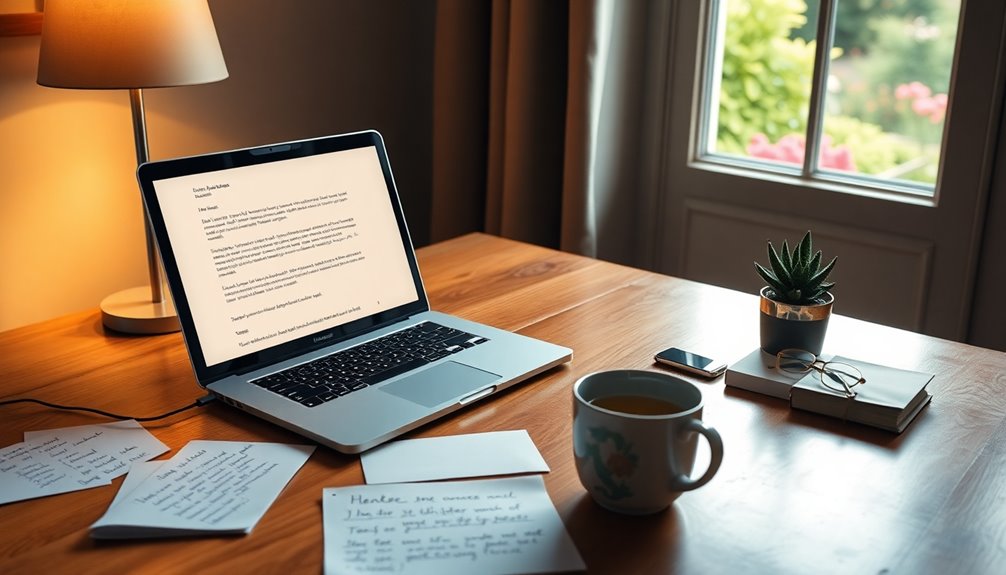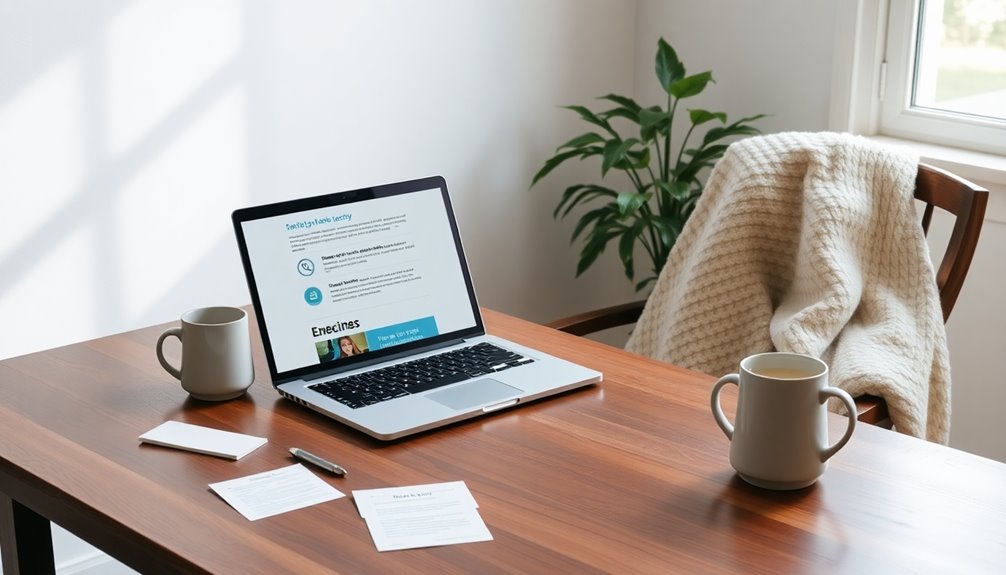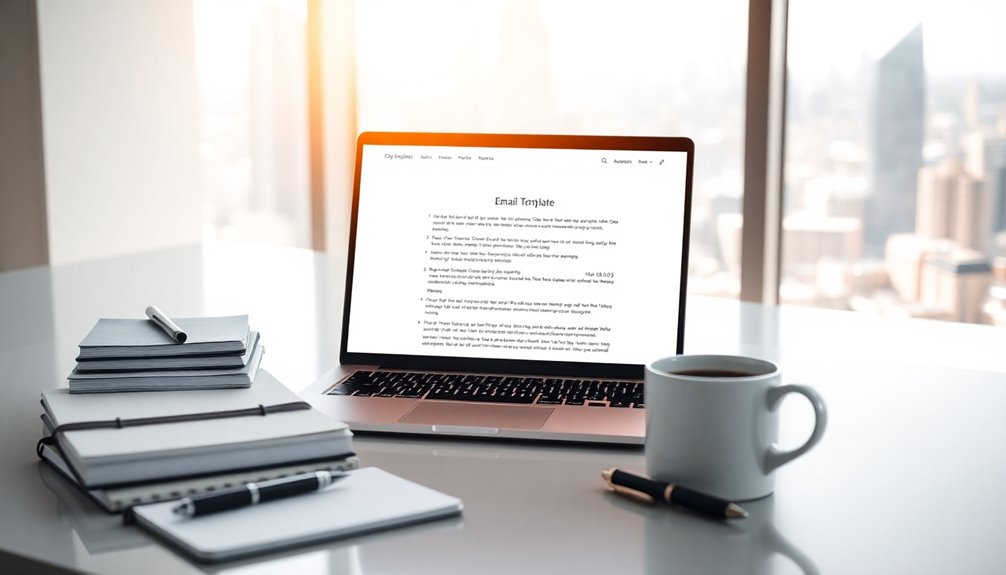When emailing your therapist, start with a personalized subject line to catch their attention. Begin your message with a friendly greeting and introduce yourself, including relevant details like your age or occupation. Clearly state why you're seeking therapy to set a professional tone and build trust. Be concise and respectful of their time while sharing enough context to prompt understanding. Also, consider asking about their availability and clarify financial aspects if needed. Lastly, avoid oversharing and maintain professionalism throughout. These tips can enhance your communication and open the door to more effective conversations ahead.
Key Takeaways
- Start with a personalized subject line that reflects your intent, sparking the therapist's interest and creating familiarity.
- Introduce yourself clearly, including your age and occupation, while stating the purpose of seeking therapy.
- Outline your challenges and therapy goals to provide context and foster a tailored therapeutic approach.
- Ask about the therapist's availability and suggest scheduling options, demonstrating flexibility and commitment to therapy.
- Include specific questions about rates and insurance to ensure clarity and avoid misunderstandings.
Introduction

When you reach out to a therapist via email, you're taking an important step toward building a supportive relationship. This initial communication sets the tone for your future interactions and helps establish a professional connection. A well-structured email allows you to provide essential context about your needs, enabling the therapist to respond more effectively.
As you compose your email, think about including specific details about your personal challenges and therapy goals. This information enhances the therapist's understanding of your situation and can lead to a more tailored approach to your therapy. Clear communication in this first email not only aids the therapist but also streamlines the scheduling process, making it easier for you to take that next step toward seeking therapy.
Additionally, utilizing email gives you the chance to express your thoughts and feelings without the immediate pressure of a phone call. You can reflect on what you want to share and articulate your needs more clearly.
This method of reaching out fosters a sense of comfort, encouraging you to seek the support you deserve as you begin your journey in therapy.
Builds Initial Trust Quickly

A well-crafted email not only initiates communication but also builds initial trust between you and your therapist. When you take the time to introduce yourself and share relevant information in your first email, you set a positive tone for your therapeutic relationship. Including your name, preferred pronouns, and specific therapy goals helps the therapist understand your needs and demonstrates openness.
Mentioning how you found the therapist, whether through a referral or online research, can create a sense of connection. This acknowledgment shows that you're actively seeking a good fit for your needs. Additionally, expressing vulnerability by briefly sharing the issues you're facing fosters empathy. When your therapist understands your situation, it paves the way for a supportive environment where you'll feel comfortable.
Keeping your email concise yet informative is crucial. It respects the therapist's time while clearly outlining your needs. By doing this, you create a solid foundation of trust that encourages both you and your therapist to engage openly.
Ultimately, your first email serves as a stepping stone toward a successful therapeutic journey, enhancing your chances of building a meaningful connection. It sets the tone for open communication and demonstrates your commitment to addressing your needs thoughtfully and proactively. Whether you’re reaching out to therapists or learning how to write an effective email to companies, clarity and sincerity are key to fostering trust and understanding. By taking this initial step with care, you pave the way for a collaborative and fulfilling relationship.
Personalized Subject Line

Crafting a personalized subject line is vital for grabbing your therapist's attention and ensuring your email stands out in their inbox. A well-thought-out subject line increases the likelihood of your email being opened and read, making it essential to communicate effectively.
Start by including your therapist's name; this creates a sense of familiarity and signals that your email is specifically directed to them. Next, mention a specific reason for your therapist inquiry, like "Seeking Support for Anxiety." This helps the therapist quickly understand the context of your email and makes it easier for them to respond appropriately.
By personalizing the subject line, you help distinguish your message from generic or spam emails, which is crucial since therapists often receive numerous inquiries. Aim for a subject line that's concise yet descriptive, ideally between 6 to 10 words. This length maintains clarity while ensuring you capture attention.
A personalized subject line not only opens the door for effective communication but also sets the tone for a constructive conversation ahead. Remember, your goal is to create a connection and invite your therapist into your experience right from the start.
Crafting Your Introductory Message

Starting your email with a personalized greeting sets a respectful tone and fosters connection. Address the therapist by name to make your message feel more engaging.
Next, clearly state the purpose of your email. Share your specific reasons for seeking therapy, whether it's anxiety, depression, or relationship issues. Briefly introduce yourself, mentioning your age and occupation to provide context that may help the therapist understand your situation better.
After that, ask about the therapist's availability for new clients. To streamline scheduling, propose a few days and times that work for you. This shows you're proactive and respectful of their time.
Additionally, inquire about session rates and accepted insurance providers. It's essential to address financial considerations early on, so don't hesitate to ask if they offer a sliding scale option.
Using email templates can help structure your message effectively while ensuring you include all necessary details. This way, you can focus on opening a meaningful dialogue with the therapist while addressing important logistical aspects like availability and insurance coverage.
Pro Tips for Maximizing Impact

Maximizing the impact of your email to a therapist can significantly influence their response and your potential connection. Start by personalizing your message; use the therapist's name and mention how you found them. This establishes rapport and makes your inquiry more engaging.
Clearly outline your mental health concerns and goals for therapy. This helps them assess fit and tailor their responses effectively. In your email, include your availability for a consultation. This shows flexibility in scheduling and can facilitate a quicker response from the therapist.
Aim to keep your email concise yet informative. Provide sufficient context about your situation while ensuring it's easy to read and understand. Maintain a professional tone throughout your email, as this sets a positive tone for the potential therapeutic relationship and demonstrates your seriousness about seeking help.
Common Mistakes to Avoid

When reaching out to a therapist, it's easy to make common mistakes that can undermine your message. One of the biggest errors is using overly casual language or slang. A professional tone establishes respect and reflects your seriousness about therapy.
Another mistake is sharing excessive personal information right off the bat. Instead, focus on key issues and therapy goals to keep your email concise and relevant.
Avoid making assumptions about the therapist's availability or services; politely inquire about their current openings and specialties to ensure a good fit.
Proofreading your email is crucial. Typos and grammatical errors can detract from the professionalism of your message, making it less likely you'll get a positive email response.
Additionally, steer clear of vague questions regarding pricing or services. Be specific about what you're seeking, as this clarity facilitates a more productive conversation and helps the therapist understand your needs.
Furthermore, consider mentioning any relevant financial circumstances that may impact your therapy needs, as this can help the therapist better tailor their approach.
Introductory Inquiry Template Example

Additionally, it's wise to ask about rates and insurance options.
This information can facilitate scheduling and help you prepare financially.
Conclude your email with a concise closing statement.
Something like, "Thank you for your time, and I look forward to your response," expresses appreciation and eagerness to hear back.
Following this structure will help you effectively email a therapist and initiate an important conversation about your mental health.
Final Thoughts

Engaging with a therapist through email not only streamlines the initial communication but also sets the stage for a productive therapeutic relationship. By taking the time to craft your initial email, you can clearly express your mental health challenges and therapy goals. This thoughtful approach helps the therapist assess if they're a good fit for your needs.
When you include specific details about your situation, you create a solid foundation for understanding and collaboration. Remember, it's essential to maintain a professional tone in your client emails. This professionalism can foster respect and encourage an open dialogue.
Flexibility in scheduling consultations is crucial, too. By showing your willingness to accommodate their availability, you're making it easier for the therapist to engage with you.
If you don't receive a response within a week, don't hesitate to send a brief reminder email. This demonstrates your commitment to seeking help and reinforces the importance of the conversation you wish to start.
Frequently Asked Questions
How Do You Write an Introductory Email to a Therapist?
To write an introductory email to a therapist, start with a friendly greeting, briefly introduce yourself, state your purpose, outline your challenges, express your therapy goals, and ask about their availability and session rates.
How Does a Therapist Start a Conversation?
A therapist starts a conversation by creating a safe space, asking open-ended questions, and actively listening. They reflect on your thoughts, share observations, and encourage you to explore your feelings, fostering trust and open communication.
How to Write an Email to a Potential Therapist Subject Line?
When writing an email to a potential therapist, use a clear subject line. For instance, you might say, "Your Name – Inquiry About Therapy." This helps them quickly understand your purpose and improves communication.
What Do You Say When You Email a Therapist?
When you email a therapist, introduce yourself with your name, age, and occupation. Describe your challenges, state your therapy goals, and ask about their availability, rates, and insurance acceptance for clarity and connection.









